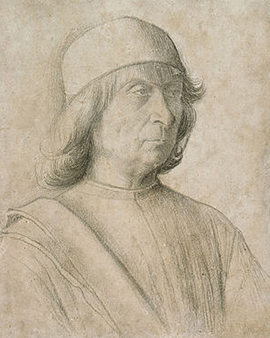Gentile Bellini, a master painter and medalist from Venice whose lifespan stretched from the beginning year 1429 to his last breath on February 23, 1507, left an incomparable stamp on the world of art. Gentile, the eldest scion of the renowned Jacopo Bellini, first manifested his artistic identity through a portrait of the Madonna in 1460, which displayed his father's stylistic traits in full glory. It was also at this time that he was chosen with his brother to provide paternal assistance in the creation of an altar in Padua. Two years after this artistic consecration, in 1466, Gentile was commissioned by the Scuola of San Marco, a brotherhood, to decorate the doors of their organ with his artistic precision. A task whose results have been preserved to this day, impressively reflecting the rigorously simple aesthetics shaped by the Paduan school of Francesco Squarcione and Andrea Mantegna. In the same year he was also commissioned to design two themes from Exodus for the great hall of the Society, which was considered no less than an imitation of his father's works.
After 1474, Gentile's reputation in his native Venice rose steadily, exemplified by the Senate's commission to restore and renew a series of murals damaged by damp. These paintings, which impressively showcased Venetian history, adorned the walls of the Great Council Chamber in the Doge's Palace and remain an impressive testament to his artistry today. The next significant turn in Gentile's life and career occurred when he was summoned by the Ottoman Empire. Sultan Mehmed II, who valued Venetian skills, sent an envoy to Venice requesting the services of an outstanding painter for his court. Gentile Bellini, convinced of the excellence of his work, was chosen for this prestigious task. During his stay in the Ottoman Empire, he produced impressive works, including a lively painting depicting the reception of an ambassador in the city and a charming watercolor portrait of a scribe. These works, reproductions of which are now available as high-quality fine art prints, present themselves as fascinating glimpses into a bygone era and culture.
Upon his return to Venice, Gentile continued his work on the Doge's Palace, completing a commission for an extensive series of frescoes that illustrated Venice's involvement in the dispute between the papacy and Emperor Frederick Barbarossa. These works, which were intended to withstand Venice's humid climate, were executed on canvas and probably in oil. However, they were lost in a fire in 1577. The last years of Gentile's life were marked by the creation of paintings related to the famous relic of the Scuola of San Giovanni Evangelista, a supposed fragment of the Holy Cross. The last great work, La predica di S. Marco ad Alessandria, was completed only posthumously by his brother Giovanni. Each work by Gentile Bellini is a magical journey through time and history, enriched by a masterful hand and a distinctive style. And today they are available as high quality art prints that allow you to experience a part of this extraordinary artistic heritage in your own home.
×





 - (MeisterDrucke-87236).jpg)
 - (MeisterDrucke-87236).jpg)
.jpg)
.jpg)
.jpg)
.jpg)
.jpg)
.jpg)
.jpg)
.jpg)
 - (MeisterDrucke-36433).jpg)
 - (MeisterDrucke-36433).jpg)
.jpg)
.jpg)
.jpg)
.jpg)
.jpg)
.jpg)
.jpg)
.jpg)
.jpg)
.jpg)
 - (MeisterDrucke-70097).jpg)
 - (MeisterDrucke-70097).jpg)
.jpg)
.jpg)
.jpg)
.jpg)
.jpg)
.jpg)
 Doge of Venice (see also 60649) - (MeisterDrucke-66008).jpg)
 Doge of Venice (see also 60649) - (MeisterDrucke-66008).jpg)
.jpg)
.jpg)
 1480 - (MeisterDrucke-110459).jpg)
 1480 - (MeisterDrucke-110459).jpg)
.jpg)
.jpg)
_tempera_-_(MeisterDrucke-1463227).jpg)
_tempera_-_(MeisterDrucke-1463227).jpg)
 - (MeisterDrucke-275263).jpg)
 - (MeisterDrucke-275263).jpg)
.jpg)
.jpg)
.jpg)
.jpg)
.jpg)
.jpg)
_(Saint_Laurent_Justinien)_-_par_Bell_-_(MeisterDrucke-941382).jpg)
_(Saint_Laurent_Justinien)_-_par_Bell_-_(MeisterDrucke-941382).jpg)
.jpg)
.jpg)
.jpg)
.jpg)
.jpg)
.jpg)
.jpg)
.jpg)
.jpg)
.jpg)
.jpg)
.jpg)
.jpg)
.jpg)
.jpg)
.jpg)
.jpg)
.jpg)
.jpg)
.jpg)
.jpg)
.jpg)
.jpg)
.jpg)
.jpg)
.jpg)
.jpg)
.jpg)
.jpg)
.jpg)
 1465 - (MeisterDrucke-142310).jpg)
 1465 - (MeisterDrucke-142310).jpg)
.jpg)
.jpg)
.jpg)
.jpg)
.jpg)
.jpg)
.jpg)
.jpg)
_-_(MeisterDrucke-1584914).jpg)
_-_(MeisterDrucke-1584914).jpg)
.jpg)
.jpg)
.jpg)
.jpg)






